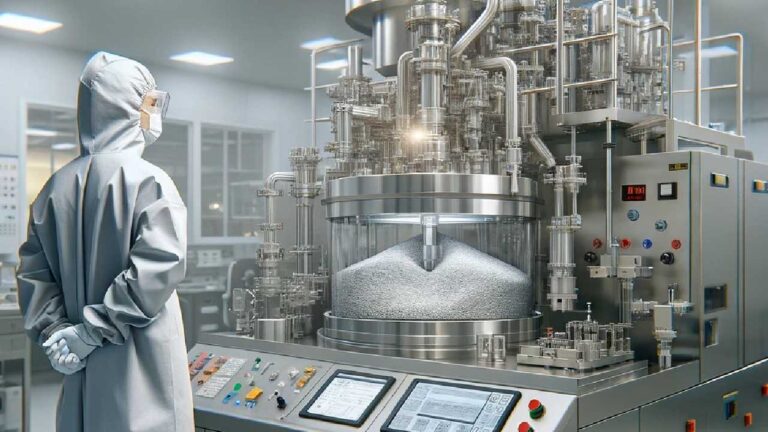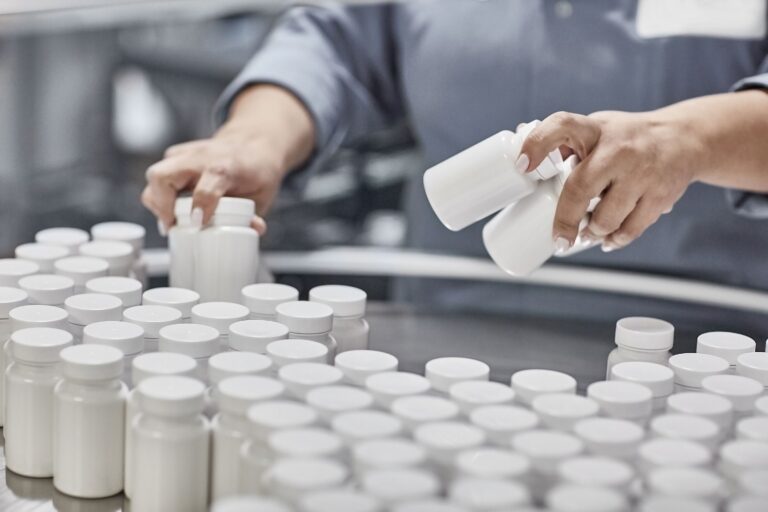
Clinical manufacturing, an important step in the pharmaceutical world, plays a vital role in bringing new drugs to market. While the term might sound complex, understanding the basics of clinical manufacturing is essential for anyone interested in the journey from drug development to clinical trials and eventual commercial availability.
In this article, we’ll understand the concept of clinical manufacturing, covering its significance, processes and key components.
What is Clinical Manufacturing?
Clinical manufacturing is a distinct and specialized branch within the sector of pharmaceutical production. Clinical manufacturing produces drugs for clinical trials on a smaller scale with the sole focus is on the creation of drugs meant exclusively for clinical research purposes. These trials are conducted to test the safety, efficacy, and dosage before approval for general use. The process requires careful attention to detail with the aim to produce high-quality drug formulations.
These drugs, which are named clinical trial materials (CTM), start their journey through various stages of testing to ensure they meet the criteria of being both safe and effective for human use. The global clinical trials market size was valued at USD 80.7 billion in 2023. It is projected to grow at a compound annual growth rate (CAGR) of 6.49% from 2024 to 2030.
Clinical Trial Manufacturing vs Clinical Manufacturing
The terms “clinical trial manufacturing” and “clinical manufacturing” are often used interchangeably in the pharmaceutical industry, but they can have slightly different nuances depending on the context.
Clinical Trial Manufacturing:
Clinical trial manufacturing specifically refers to the process of producing drug products or medical devices for use in clinical trials. This involves the production of small-scale batches that are designed to meet the specific requirements of a clinical study. The focus is on creating a product that can be used to evaluate the safety, efficacy, and pharmacokinetics of a new drug or medical device in human subjects. The manufacturing process must adhere to Good Manufacturing Practices and other regulatory standards to ensure the quality and safety of the product.
Key aspects of clinical trial manufacturing include:
- Formulation development and optimization.
- Production of small batches for Phase I, II, or III trials.
- Packaging and labeling that meet trial-specific requirements.
- Compliance with regulatory guidelines for clinical trials.
Clinical Manufacturing:
Clinical manufacturing is a broader term that includes the production of pharmaceutical products or medical devices intended for use in a clinical setting, which includes clinical trials. It can refer to the manufacturing of products for both investigational use in clinical trials and commercial use after regulatory approval. In the context of clinical trials, clinical manufacturing involves the same processes and requirements as clinical trial manufacturing.
However, when referring to the broader scope of clinical manufacturing, it may also include:
- Large-scale production of approved drugs for commercial distribution.
- Manufacturing of products for compassionate use or expanded access programs.
- Production of clinical supplies for ongoing patient care in a hospital or clinical setting.
In summary, clinical trial manufacturing is a specific subset of clinical manufacturing focused on producing products for clinical trials. Clinical manufacturing, on the other hand, can refer to the broader production of products for clinical use, including both investigational and approved products.
Purpose of Clinical Manufacturing:
Clinical Trial Material allows researchers to test new drugs in clinical trials. When a new drug is produced, it undergoes precise clinical trials to assess its safety for the general public. In these trials, researchers closely observe patients to evaluate both the safety and effectiveness of the drug. Based on the findings from these studies, the drug advances through four specific phases.
Unlike other similar materials, clinical trial materials are not made with the intent of public consumption. Instead, their significance lies in their contribution to determine the success and viability of a drug in its initial developmental stages. Clinical manufacturing is the precondition for the rigorous testing and analysis that unfolds during clinical trials. While commercial drugs aim for mass distribution and consumption, clinical trial materials are tailored for a more focused audience—participants in carefully monitored clinical trials.
Through this specialized process, the pharmaceutical industry covers its journey from drug conception to understanding its real-world impact. Thus, clinical manufacturing is not only a separate entity within pharmaceutical production but is also a necessity for the progression of new drugs towards market availability.
Key Components of Clinical manufacturing
The key components of clinical manufacturing include:
Clinical Trial Materials (CTM):
Clinical trial materials (CTM) serve as the tangible outcome of the complex process that is clinical manufacturing. These are the drugs meticulously manufactured specifically for testing within the controlled environment of clinical trials.
Made in a finished form suitable for administration, CTM plays a vital role in the comprehensive evaluation of a drug’s potential. Administered to trial participants, these materials become the conduits through which researchers collect essential data. This data, in turn, provides important insights into the drug’s safety, efficacy and potential side effects.
In the context of clinical trials, CTM serves a dual purpose: not only does it represent the culmination of meticulous manufacturing processes, but it also becomes the medium through which the drug’s performance is observed and analyzed. The data gathered during the administration of CTM becomes the cornerstone upon which decisions regarding the drug’s future progression are made.
Process of Clinical Manufacturing and cGMP Guidelines
The clinical manufacturing process involves the following steps:
Planning and Timeline:
At the heart of clinical manufacturing lies a careful planning phase, an essential condition to the journey of drug development. Before the actual manufacturing of clinical trial materials commences, a detailed plan and timeline are meticulously established. This serves as a comprehensive roadmap, guiding the entire development and clinical trial process.
The significance of this planning phase cannot be overstated. It allows for the strategic organization of activities, ensuring a systematic and coherent approach to drug development.
Researchers and manufacturing teams collaborate to understand the intricate sequence of steps involved, creating a structured framework that sets the stage for the subsequent stages of clinical manufacturing.
Flexibility in Manufacturing:
In the dynamic sector of clinical manufacturing, flexibility is not just an attribute but a necessity. Unlike the standardized and rigid processes of commercial manufacturing, the clinical manufacturing landscape demands adaptability.
This flexibility becomes particularly important during phases I and II trials, where formulations and dosages may need adjustments based on evolving requirements.
The ability to make necessary changes without causing significant delays is significant. Challenges such as formulation issues or unexpected regulatory updates can arise and the flexibility embedded in the clinical manufacturing process allows for swift adaptations.
This ensures that the development timeline remains on track, minimizing disruptions and facilitating a seamless progression from one phase to the next.
cGMP Guidelines:
cGMP refers to the set of regulations established by the United States Food and Drug Administration (FDA). Good Manufacturing Practices are essential guidelines that ensure the quality and safety of pharmaceutical products, food, and other regulated products. These practices are designed to minimize risks involved in production that cannot be eliminated through testing the final product. The five key components of GMP are:
- Products: The focus is on the quality of the final product. This includes ensuring that products are free from contamination, are consistently produced and controlled according to quality standards, and meet their intended use. Product quality also encompasses the integrity of the product’s identity, strength, and purity.
- People: Trained and qualified personnel are crucial for maintaining GMP standards. Employees must have the necessary education, training, and experience to perform their roles effectively. Regular training and assessments are conducted to ensure that staff are aware of and competent in GMP requirements.
- Processes: Manufacturing processes must be clearly defined, validated, and controlled to ensure consistency and compliance with specifications. Changes to processes are evaluated to ensure they do not negatively impact product quality. The processes are designed to maintain the integrity of the product throughout its production and storage.
- Procedures: Documented procedures are required for all critical processes to ensure consistent performance and compliance with GMP standards. These written procedures, or Standard Operating Procedures (SOPs), provide step-by-step instructions for performing operations safely and effectively.
- Premises: The manufacturing environment, including facilities and equipment, must be suitable for the intended operations and designed to prevent contamination and errors. This includes appropriate design, maintenance, and cleaning of premises and equipment to ensure product quality and safety.
Adherence to current Good Manufacturing Practice (cGMP) guidelines is a cornerstone of ethical and high-quality clinical manufacturing. These guidelines, set forth by regulatory bodies, establish the gold standard for the manufacturing process. Important in ensuring safety and efficacy, cGMP guidelines govern every step of clinical manufacturing, emphasizing the need for precision and consistency.
By following cGMP guidelines, manufacturers commit to upholding the highest standards in the industry. This becomes especially critical in the production of biologics, where the risk of contamination is heightened.
The guidelines set the benchmark for sterile manufacturing processes, reinforcing the commitment to maintaining the integrity of clinical research.
During the early stages of making drugs, like in phase I and II trials, following the cGMP rules is really important. Hycon provides drug supplies for Phase I, II, and III clinical trials:
Clinical Study Phases Supported by Hycon
- Phase I: Involves 15 to 50 patients in small groups, focusing on safety and dosage. Successful completion leads to Phase II, where safe and effective dosages are established.
- Phase II: Typically includes fewer than 100 patients, aiming to evaluate efficacy and side effects. Advancement to Phase III depends on positive efficacy and manageable side effects.
- Phase III: Engages hundreds to thousands of patients worldwide, with random assignment to control groups or the drug being tested.
Quality Control Measures:
Quality control is the bedrock of clinical manufacturing, encompassing a comprehensive array of measures to guarantee consistency and compliance with cGMP guidelines. Covering diverse aspects, including personnel, facilities, equipment, control of components, manufacturing records, laboratory controls, packaging, labeling, distribution and record-keeping, these measures leave no stone unturned.
The control of every element within the manufacturing process ensures that each clinical trial material batch meets the highest standards. Personnel undergo rigorous training, facilities are maintained to standard specifications and every piece of equipment is calibrated for precision.
These measures collectively contribute to the production of pharmaceuticals that not only follow regulatory standards but also uphold the ethical responsibility of ensuring the safety and efficacy of drugs used in clinical trials. In essence, quality control measures are the safeguards that underpin the credibility and reliability of the entire clinical manufacturing process.
Differences Between Clinical and Commercial Manufacturing
Clinical manufacturing and commercial production are two distinct phases, each with its own set of challenges and objectives. While they share similarities, there are several key differences that set them apart. Understanding these distinctions is crucial for optimizing processes and resources in drug development and distribution.
1. Scale and Volume
One of the most significant differences between clinical manufacturing and commercial production is the scale and volume of the batches produced. Clinical trials typically involve smaller batches, allowing for tight control and monitoring of the production process.
This is essential for ensuring the safety and efficacy of the drugs being tested. In contrast, commercial production requires large-scale manufacturing to meet market demand, necessitating more automated processes and larger facilities.
2. Regulatory Requirements
Both clinical manufacturing and commercial production must adhere to regulatory standards, but the requirements and flexibility can vary between the two phases. Clinical manufacturing operates under strict protocols to ensure patient safety during testing, but there may be more flexibility in adapting processes as new data emerges.
On the other hand, commercial production must comply with more stringent regulatory standards to ensure product consistency and safety for widespread use.
3. Flexibility in Formulation
During the early stages of clinical trials, it’s common for the formulation of the drug to undergo adjustments based on trial results. This flexibility is a key aspect of clinical manufacturing, allowing for optimization of the drug’s effectiveness and safety.
In contrast, commercial production requires a more standardized formulation to ensure consistency across large-scale batches. Any changes to the formulation at this stage can have significant implications for regulatory approval and market acceptance.
4. Timeline
The timeline for clinical manufacturing and commercial production also differs. Clinical manufacturing is often a more time-consuming process, as it involves careful monitoring and analysis of small batches. Additionally, the need for flexibility in formulation and adherence to trial protocols can extend the timeline.
In contrast, commercial production benefits from economies of scale, which can result in a more streamlined and cost-effective process. Once a drug has received regulatory approval, the focus shifts to efficient production and distribution to meet market demand.
The Role of Contract Development and Manufacturing Organizations in Clinical Manufacturing
Contract Development and Manufacturing Organizations play a virtal role particularly in clinical manufacturing. Their expertise, resources, and capabilities are essential for the successful development, production, and delivery of clinical trial materials. Here’s an in-depth look at their role:
- Expertise in Formulation and Development: CDMOs offer specialized knowledge in drug formulation and development, which is crucial for creating effective and safe CTMs. They work closely with pharmaceutical companies to develop formulations that meet the specific requirements of clinical trials, ensuring the right dosage forms and delivery mechanisms are used.
- Manufacturing Capabilities: CDMOs possess the necessary infrastructure and equipment to manufacture small-scale batches of CTMs required for clinical trials. They can handle a wide range of product types, including tablets, capsules, injectables, and biologics, ensuring flexibility and adaptability in production.
- Quality Assurance and Compliance: CDMOs adhere to strict regulatory standards, such as Good Manufacturing Practices (GMP), to ensure the quality and safety of CTMs. They implement rigorous quality control measures, including testing and validation, to ensure that the products meet all necessary specifications and regulatory requirements. Hycon fosters internal partnerships through CAPA boards, change control boards, and investigation boards, leveraging the skills and expertise of our global quality network.
- Scalability: CDMOs provide scalability in manufacturing, allowing for the production of CTMs to be scaled up or down based on the needs of the clinical trial. This flexibility is crucial for accommodating changes in trial size, scope, or duration.
- Supply Chain Management: CDMOs manage the entire supply chain for CTMs, from sourcing raw materials to delivering the final product to clinical trial sites. They ensure that all materials are of high quality and that the finished products are stored and transported under the appropriate conditions to maintain their integrity.
- Regulatory Expertise: CDMOs offer regulatory expertise to navigate the complex regulatory landscape of clinical manufacturing. They assist pharmaceutical companies in preparing regulatory submissions, ensuring compliance with local and international regulations, and addressing any regulatory issues that may arise.
- Cost-Effectiveness: By outsourcing clinical manufacturing to CDMOs, pharmaceutical companies can reduce their capital investment in manufacturing facilities and equipment. CDMOs provide a cost-effective solution by offering their services on a contract basis, allowing companies to pay only for the services they need.
- Time-to-Market: CDMOs can accelerate the time-to-market for new drugs by streamlining the manufacturing process and addressing any challenges promptly. Their expertise and efficiency in producing CTMs can shorten the timeline for clinical trials and ultimately bring new treatments to patients faster.
Advancements in Manufacturing for Small Molecule Drugs:
Drug manufacturing is improving continuously. This happens because of better ways of drug production and new technology. These improvements make the manufacturing of small molecule drugs much better.
This means drugs can be developed faster, and there’s a more dependable supply of critical pharmaceuticals. Experienced CDMOs use modern manufacturing technologies to make drugs better and more accessible.
- Advanced Manufacturing Technologies:
- High-Tech Equipment: The use of the latest and best equipment to manufacture drugs is crucial. It helps ensure high-quality production and scalability.
- Innovative Manufacturing Processes: The innovative manufacturing processes are designed to enhance efficiency and reduce time-to-market.
- Advanced Analytics and Data Management:
- Data-Driven Manufacturing: Advanced analytics is utilized to optimize manufacturing processes, improve efficiency, and reduce costs.
- Robust Data Management: These systems ensure that all manufacturing data is securely stored and easily accessible for analysis and regulatory purposes.
Role of Specialty CDMOs in Clinical Trial Manufacturing:
- Expertise in Niche Areas: CDMOs that specialize in certain areas help speed up clinical trials. Specialty CDMOs focus on specific therapeutic areas or formulation technologies, offering in-depth knowledge and experience.
- Accelerated Development: Their specialization enables quicker development cycles, reducing time-to-market for new drugs. From the early stages of development to the commercialisation of the final product, CDMOs help selecting best technologies for your molecules.
- Customized Solutions: Tailored manufacturing solutions are designed specifically for specialized drugs, making sure they meet the exact needs of each drug. This precision in production guarantees that every pill or dose is made accurately and efficiently.
Benefits of Partnering with Hycon:
Drug Delivery Methods
Hycon is fully equipped for the formulation development of all small molecule dosage forms. We provide manufacturing for a wide variety of delivery modes below:
- Oral administration involves taking tablets, capsules, liquids, or powders by mouth. This method is common and convenient. Absorption occurs in the gastrointestinal tract. Examples of oral drugs include aspirin, paracetamol (acetaminophen), and antibiotics.
- Sublingual or buccal administration refers to placing drugs under the tongue or against the cheek for absorption through the oral mucosa. This method allows for rapid absorption due to the rich blood supply in these areas. It also avoids first-pass metabolism in the liver. Examples include nitroglycerin (used for angina), certain vitamins, and sedatives.
- Topical administration involves applying drugs directly to the skin or mucous membranes. This method has a local effect and limited systemic absorption. It is commonly used for skin conditions, pain relief, and local anesthesia. Examples of topical formulations include creams, ointments, and patches (such as the lidocaine patch).
- Transdermal administration delivers drugs via skin patches or creams. It provides controlled release over time and is used for systemic effects. Examples of transdermal patches include nicotine patches (for smoking cessation), fentanyl patches (for pain management), and hormone replacement therapy patches.
Connect and explore how we can support the success of your clinical trials and commercial ventures. Let’s work together to bring your innovative treatments to the patients who need them most.







